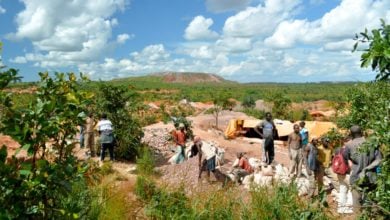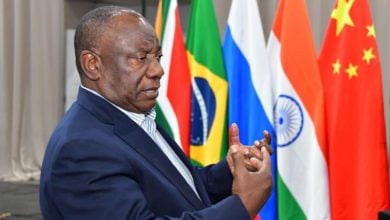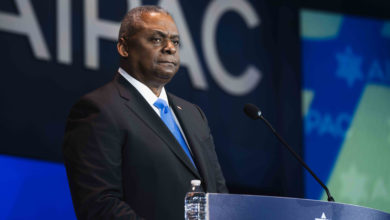Asked to describe their image of Tibet, most in the West would give the Hollywood version of reality: a nation of peace and spiritual harmony, where gentle monks live humbly side-by-side with a rustic peasant population at one with nature. In this image, it is hard to imagine the need for a government with a population so docile and free of conflict.
This image has been propagated by the imperialist media. It is contrasted with the counter-image of peaceful Tibetans brutally repressed by Chinese troops. In fact, public awareness of Tibet in general rises and falls with the periodic anti-China demonization campaigns conducted by the U.S. State Department and its agents.
 To read more from China: Revolution and Counterrevolution, click this link to purchase your copy. |
This view fails to reflect the reality of Tibetan workers and peasants under the theocratic political rule of the Dalai Lama, the title of the traditional Tibetan head of state, who is supposedly the reincarnation of a spiritual leader from the 14th century. That rule ended abruptly in 1959, when the Dalai Lama’s troops based on Tibetan landowners and elites were defeated by the Chinese Peoples’ Liberation Army.
Tibet is an autonomous region of China, meaning that it is an integral part of China and is under the ultimate authority of the Beijing government, but enjoys wide self-governing powers. Tibetans are among the approximately 56 distinct nationalities in China. Within Tibet, other nationalities include Moinbas, Lhobas, Naxis, Huis, Dengs and Sherpas.
Few in the United States would know that the elected chair of Tibet’s regional government is Qiangba Puncog, a former factory worker who joined the Communist Party of China in 1974 and spent his life in public service. Instead, U.S. propaganda has been such that Tibet is almost synonymous with the Dalai Lama, the head of the “Tibetan Government in Exile.”
This so-called government in exile, representing the former religious ruling class, is fully funded and supported by the United States. U.S. imperialist politicians and spokespeople routinely show their support for the Dalai Lama as a way of diplomatically needling the Chinese government. For example, on Oct. 17, 2007, the U.S. Congress awarded the Dalai Lama the Congressional Gold Medal of Honor—the U.S. government’s “highest civilian honor.”
When Iraq war supporters and supporters of militarizing the U.S.-Mexican border portray the Dalai Lama as “a unifying voice for global peace” and a holy man, the truth must be quite different. That can be seen by looking at the historical record of those who now try to speak in the name of Tibetan people.
Theocratic rule
Tibet became part of the Chinese empire in the 13th century, when it was conquered by Genghis Khan. Life in Tibet in the subsequent centuries was characterized by Buddhist clan fighting and feudal economic relations.
The political rule of the Dalai Lamas began in 1578. The Dalai Lamas were like god-kings, using their religious authority alongside brutal repression to govern Tibet. In 1660, for example, the fifth Dalai Lama directed the Mongol army to “obliterate the male and female lines, and the offspring too ‘like eggs smashed against rocks. … In short, annihilate any traces of them, even their names.’”1
In his book “Buddha’s Not Smiling: Uncovering Corruption at the Heart of Tibetan Buddhism Today,” Erik D. Curren describes life under the Dalai Lamas: “History belies the Shangri-La image of Tibetan lamas and their followers living together in mutual tolerance and nonviolent goodwill. Old Tibet was much more like Europe during the religious wars of the Counterreformation.”2
Tibet under the lamas was characterized by feudal economic and social relations. The source of power and wealth was land. Land, in turn, was divided among the monasteries, the nobility and the Lhasa government.
Tibet is 70 percent grassland and its economy has always been agricultural. Until 1959, most of the arable land was organized into manorial estates. These estates were owned by elite landowners or rich monasteries and were worked by serfs. Most rich monasteries amassed wealth through active participation in trade, commerce and money lending. Children were conscripted from poor families against their will to join monasteries at a young age and work for life.
Second in political power to the lamas was a feudal hereditary aristocracy. Most descended from an aristocracy dating back to before the Mongolian invasion. The commander-in-chief of the Tibetan army, a member of the Dalai Lama’s cabinet, owned 4,000 square kilometers of land and 3,500 serfs.3
The vast majority of Tibetans were serfs or peasants. Others occupied lower ranks in the social hierarchy as slaves and beggars. Serfs faced a lifetime of servitude at the disposal of lords and the monasteries. They were bound to the land without pay and they had no access to education or medical care. Serfs raised livestock and field crops and transported their lords on demand. They could not even choose to marry without the consent of a lord or a lama.
Serfs were heavily taxed by both the aristocratic landowners and monasteries. Taxes supported the rule of the theocracy. Serfs were taxed upon marriage, childbirth and death. Taxes were also levied for, among other activities, planting trees, keeping animals, religious festivals, going to prison, being unemployed and travel. If the taxes were not paid, the debt was either handed down to family members or paid by a monastery at up to 50 percent interest. Those who could not pay faced slavery.4
Imperialist interests
Entering the 20th century, Asia was a battleground for the world imperialist powers. Tibet was no exception. In addition to its forest and mineral wealth and proximity to oil, Tibet occupied a strategic geopolitical place in Asia. Tibet borders India and Nepal to the south. British and U.S imperialism looked to Tibet as a gateway to the heart of China.
In 1904, British troops from India invaded Tibet. Maj. Francis Younghusband led an expedition to seize Lhasa, carrying out several massacres along the way. After seizing the capital, Younghusband forced officials there to sign a treaty recognizing British mercantile interests in Tibet. In 1906, the British imposed similar terms on the disintegrating Chinese regime. China had by that time been forced to sign unequal treaties with all the imperialist powers.
In 1911, the Chinese empire collapsed in the face of a revolutionary military uprising. In 1912, Sun Yat-sen declared China a republic. In the power struggles that followed, central authority weakened as power was dispersed to various warlords across China. Tibet essentially functioned as an separate entity—still under the protection of Britain—although no government in the world recognized independence.
After the revolution
The victory of the 1949 Chinese Revolution marked a turning point for Tibet. In 1949, the Communist Party of China had drafted a constitution that included the provision that “all Mongolians, Tibetans, Miao, Yao, Koreans and others living in the territory of China shall enjoy the full rights to self-determination.”
No area constituted a greater challenge for the communists than Tibet. The CPC had decades of practical experiences in dealing with the complicated problems of building unity with the many oppressed peoples and nationalities throughout China. During the historic Long March of 1935, Mao led the 7,000-plus-mile retreat from southern China. In each region, with the exception of Tibet, the communist-led Red Army was able to negotiate terms of friendship with the national minorities, who provided food and shelter for the retreating peasant army.
In Tibet, the local population was still so much under the domination of the religious ruling class that the communists made little progress. The Red Army was met with so much hostility that they could not buy food from the local populace and thus they had to forcibly procure what they needed to survive. Mao described these problems to the world-famous chronicler of the Chinese revolution, Edgar Snow.
“This is our only foreign debt, and some day we must pay the Mantzu (sic) and the Tibetans for the provisions we were obliged to take from them.”5
It is likely that China would have proceeded very cautiously with the introduction of central government control, and especially socialist measures in Tibet, had it not been for international factors. Shortly after the United States invaded Korea in June 1950 under the mantle of the United Nations, the Tibetan ruling-class political parties appealed to the same United Nations to intervene in Tibet.
Ironically, the Soviet Union was boycotting the U.N. Security Council as a protest against the refusal to seat the People’s Republic of China in the Security Council following the 1949 victory. Thus, the United Nations was turned into a complete puppet for U.S. foreign policy. At the same time that China was preparing to send more than a million soldiers to fight against advancing U.S. troops on its eastern border in late 1950, it made the decision to also move its army into Tibet on its western border.
In 1950, the first units of the People’s Liberation Army entered Tibet. As the first presence of Chinese authority in nearly 40 years, the revolutionary army was initially greeted with distrust. Tibetan lords and monasteries in particular feared the new armies, because they feared that the Chinese communists would redistribute land and endow serfs and slaves with rights.
But the Chinese communists came armed with a Leninist position on national minorities—expressed in their recognition of the right to self-determination—and the class loyalties of peasants of all nationalities. When Tibetan aristocrats tried to militarily block the PLA from entering Tibet, most of the peasant troops defected and crossed to the side of the communist troops.
In May 1951, Tibetan and Chinese leaders signed the “Agreement of the Central People’s Government and the Tibetan Local Government on Measures for Peaceful Liberation of Tibet.” This agreement, known as the 17-Point Agreement, recognized that “the Tibetan people shall be united and drive out the imperialist aggressive forces from Tibet; that the people of Tibet shall return to the big family of the motherland, the People’s Republic of China.” Guided by the principle of self-determination, the agreement recognized the rule of the Dalai Lama and the freedom of religion. It further recognized and promoted the Tibetan language and culture.
Over the next years, a class struggle emerged in Tibet based on the continued existence of the old feudal ruling class coexisting with the Chinese revolution’s advancing of workers’ and peasants’ rights. The new revolutionary central government concentrated its efforts and resources on building schools, roads and highways in Tibet. The Chinese also distributed newspapers and introduced telephone and postal service. Communists built hospitals and health clinics in rural regions of Tibet where people had never seen health care. Interest rates were reduced, although the communists did not initially confiscate any estates.6
As land reform efforts gained momentum, however, the hostility of the Tibetan feudal lords mounted. Meanwhile, U.S. and British imperialists saw the opportunity to regain influence in the region and at the same time roll back communist influence.
Beginning in the early 1950s, the U.S. Central Intelligence Agency began to train counterrevolutionary military units in Tibet. Many of those recruited were members of the former elite. Gyalo Thondup, for example, the Dalai Lama’s older brother, coordinated military action with the CIA from a U.S. base in India and Nepal.7
In 1956-57, CIA-trained rebel forces in Tibet attacked a PLA outpost in Lhasa.8 The rebel militias disintegrated, however, failing to win public support. In March 1959, landlord-backed rebels marched into Lhasa, killing or wounding anyone suspected of cooperating with the revolutionary government. Despite this, PLA troops stayed in their barracks for 10 days.
Journalist Anna Louise Strong reports the explanation she was given by PLA officials:
“The ‘kasha’ was still the lawful government and the people of Lhasa had not yet taken sides. In such situations, our strategy is always never to start or develop the fighting but let the enemy start it and continue it until it is fully clear to all people who are the aggressors and the destroyers of law. Then, when we counter attack, we have the people with us, their support shortens the fighting and lessens the casualties in the end. The rebels lost the people of Lhasa in those ten days.”9
Following the failure of this reactionary armed uprising in 1959, the Dalai Lama fled to India to establish a new “government in exile.” The Chinese government recognized the authority of the second most influential lama, the Panchen Lama, in the Dalai Lama’s absence. Former serfs voted for the first time ever in 1961. In 1965, China recognized the Tibetan Autonomous Region.
From the early 1960s until 1973, “Khamba” contras carried out attacks on Tibet from bases in the Walanchung-gola and Mustang regions of Nepal. The “Tibetan Government in Exile” received approximately $1.7 million per year from the CIA. Contras were airlifted into Tibet for attacks against the government.10
In the subsequent decade, the religious theocracy was dismantled, bringing about a very different social structure in Tibet. Slavery was abolished, many of the taxes were eliminated and serfs were given paid employment on new civic projects, such as establishing running water and building infrastructure.
The fruits of liberation
Today, monasteries are open in Tibet and monks are free to practice their religion. In the new social structure, religion is no longer used as an instrument of repression.
Economic development, a goal for all of China, has been even more vital in Tibet as one of the most underdeveloped regions of an underdeveloped country. Gross domestic production grew by a factor of 30 between 1951 and 2000. In 1950, there was a single 125-kilowatt power station in the entire region; in 2000, there were 401 power plants producing 356,200 kilowatts.
In pre-revolution Tibet, there were no schools at all. Education was the sole province of the monasteries. By 2000, 86 percent of school-age children were enrolled in schools.
Even relative to the rest of China, conditions in Tibet are becoming comparable. In 2000, the number of hospital beds and doctors per thousand population is higher than for China overall.11
None of these gains would have been possible under the old imperialist-backed ruling class.
In fact, it is precisely regions like Tibet—among China’s least developed regions—that stand to lose the most in the event of a counterrevolution in China. Tibetans would find themselves in the position of the citizens of the Caucasus or other poorer republics of the former Soviet Union, who have seen unemployment and poverty skyrocket since the restoration of capitalist rule in 1991.
Tibetan workers and peasants—like workers and peasants from the other national minorities in China—undoubtedly weigh the benefits of unity with China against the exiles’ misleading promises of the green pastures of independence.
For that reason, socialists and progressive people have nothing in common with the “Tibetan government in exile” or the Dalai Lama.






